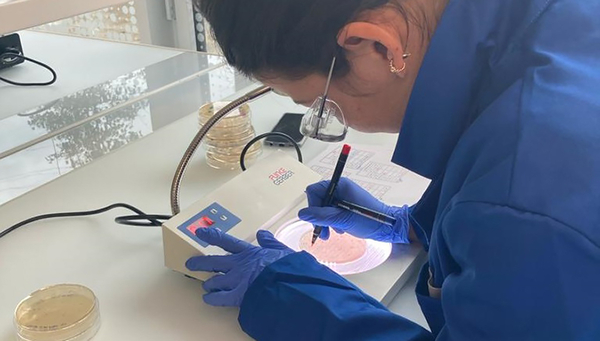Archive detail
Antibiotic-resistant bacteria in wastewater
June 6, 2024 |
The problem of antibiotic-resistant bacteria is well known and represents a growing danger that is already claiming millions of lives worldwide. Yet, little is known about the spread of such resistant bacteria. Current estimates mainly relate to cases in which resistance is detected in hospitals. However, it is difficult to estimate whether and how many people in the community are carrying antibiotic-resistant bacteria. “Measurements in wastewater can shed some light on the matter,” says Sheena Conforti for the aquatic research institute Eawag.
Over the course of a year, Conforti’s team analysed the wastewater from six wastewater treatment plants throughout Switzerland on a weekly basis. The researchers focused on Escherichia coli bacteria, in particular the resistant ESBL-E. coli. On average, 1.9% of the E. coli bacteria found were resistant ESBL variants. “This value is in the lower range of comparable European data, which other studies have shown ranges from 1.6% in Greece to 4.4% in Germany,” Conforti notes.
In addition to estimating the Swiss average value of 1.9%, the team was able to gain further insights based on the location of the wastewater treatment plants. Zurich, Geneva and Lugano showed a significantly higher percentage of ESBL-E. coli in wastewater than samples from Chur, for example. The researcher attributes this to several factors. On the one hand, wastewater treatment plants in larger cities treat wastewater from correspondingly more densely populated catchment areas; on the other hand, it is logical that the spread of transmittable bacteria is higher in more densely populated areas. In addition, both Geneva and Zurich have international airports, as well as numerous hospitals and clinics. All of these factors favour the spread of resistant bacterial strains. “Our results emphasise the potential of wastewater as an indicator of the prevalence of ESBL-E. coli in the population,” says Conforti.
Wastewater data as a basis for calculating the number of affected people
The study also suggests the need for additional research to more precisely determine the likely number of people affected in the population. An important factor is missing. The ratio of resistant E. coli to treatable E. coli bacteria in the intestines of affected people (the researchers refer to this as the shedding load), and the question of whether this ratio is similar for all carriers. Together with the data from the wastewater, this value could be used to derive how many people in the catchment area of the wastewater treatment plant are affected with resistant bacteria. Conversely, the shedding load could be calculated using the wastewater data if the actual number of carriers were known.
So far, only estimates and data from other countries are available for both of these factors: the shedding load and number of affected people. These lie within a wide range. In Europe, for example, it is assumed that 6% of the population carries antibiotic-resistant ESBL- E coli, which, together with the data from Swiss wastewater, would lead to a shedding load of 32% in affected people in Switzerland. If one runs the calculation with a value for the shedding load of ESBL-E. coli from a study from Bangladesh (19%) with the wastewater data for Switzerland, an estimated 10% of the Swiss population would be carrying resistant E. coli. However, there are no figures from Switzerland for either the proportion of ESBL-E. coli or for the number of carriers. These values are therefore estimates.
Monitoring for early detection
The measurement frequency can also have an influence on the results, as the team discovered. In previous European studies, samples from wastewater treatment plants were also analysed, but sometimes only once per season. This leads to less accurate results, as temperature and weather conditions can distort the data. However, tight monitoring checks are time-consuming and costly. According to Conforti, the ideal frequency is therefore between once and twice a month. This may be relevant if regular wastewater measurement were to be included in national monitoring endeavours.
The work of the Eawag researchers was supported by the National Science Foundation and the Federal Office of Public Health, among others. The study, recently published in the journal mSphere of the American Society for Microbiology, has met with widespread interest. In the meantime, Conforti has expanded the monitoring of wastewater samples to include other potentially resistant pathogens. These include MRSA (methicillin-resistant Staphylococcis aureus), VRE (vancomycin-resistant enterococci) and CRE (carbapenem-resistant Enterobacteriaceae). These pathogens pose a hazardous risk similar to that of the resistant E. coli bacteria. That makes it all the more important to monitor their spread. In view of the difficulties in treating AMR infections in hospitals, monitoring in wastewater at least provides initial indications and may help to launch preventive measures at an early stage.
Original publication
Monitoring ESBL-Escherichia coli in Swiss wastewater between November 2021 and November 2022: insights into population carriage
Cover picture: Eawag researcher Sheena Conforti determining the bacteria in the analysed wastewater samples (Photo: Eawag, Melissa Pitton).
Financing / Cooperations
- BAG
- SNF


